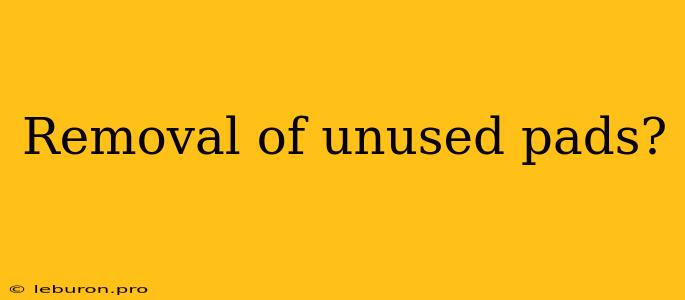The concept of "unused pads" can apply to various contexts, from physical objects like adhesive pads to digital elements like memory pads. Regardless of the context, the process of removal of unused pads often involves carefully considering the impact and ensuring a smooth transition. This article will delve into the different types of unused pads, the reasons behind their removal, and the best practices for a successful process.
Understanding the Types of Unused Pads
Before diving into the removal of unused pads, it's crucial to understand the various types we encounter. Here are some common examples:
Physical Pads:
- Adhesive Pads: These are typically found on objects like wall decals, furniture protectors, or temporary mounting solutions. The removal of unused pads in this case involves carefully peeling them off the surface, ensuring no residue is left behind.
- Padding for Protection: Packaging materials, cushions, and other protective elements often use padding to prevent damage during transportation or storage. Removal of unused pads in this context might involve recycling or discarding the padding based on its material and condition.
Digital Pads:
- Memory Pads: In the context of computer memory, unused pads refer to memory modules that are not actively used by the system. This might happen if a system has more memory than it requires or if certain modules are faulty or incompatible.
- Digital Design Elements: In graphic design or web development, "pads" might refer to areas of empty space, often used for visual appeal and hierarchy. Removing unused pads in this context might involve adjusting the layout or content placement to create a more efficient and visually pleasing design.
Reasons for Removing Unused Pads
Removal of unused pads is often driven by several factors, including:
- Space Optimization: Unused pads can take up valuable space, whether it's in a physical storage unit, a computer system, or a digital design. Removing them allows for better utilization of the available space.
- Performance Enhancement: In digital systems, unused pads can sometimes hinder performance. For example, excessive memory pads can lead to slower processing speeds. Removing them can streamline operations and improve system efficiency.
- Resource Management: Removing unused pads allows for better management of resources. This could involve freeing up storage space, reducing energy consumption, or optimizing system performance.
- Aesthetics and Functionality: In design contexts, unused pads can affect the visual appeal and functionality of a product or interface. Removing them can create a cleaner, more streamlined experience.
Best Practices for Removal of Unused Pads
The removal of unused pads should be approached with care and consideration, especially in contexts where it might impact system functionality or aesthetics. Here are some general best practices to follow:
Physical Pads:
- Gentle Removal: When removing adhesive pads, use a slow and steady motion to avoid tearing or damaging the underlying surface.
- Residue Removal: Depending on the type of adhesive, you might need to use a cleaning solution to remove any residue left behind.
- Proper Disposal: Dispose of the removed pads responsibly, considering their material composition and potential recycling options.
Digital Pads:
- System Backup: Before removing any digital memory pads, always create a backup of your system to ensure data recovery in case of any unforeseen issues.
- Compatibility Check: Ensure any new memory modules you install are compatible with your system specifications.
- Testing and Optimization: After removing or adding memory pads, run system tests and optimize settings to ensure smooth operation and optimal performance.
- Design Review: When removing unused digital design elements, carefully review the impact on overall aesthetics and functionality before making any final changes.
Conclusion
The removal of unused pads is a process that requires careful consideration and a systematic approach. Understanding the different types of pads, the reasons behind their removal, and the best practices for a successful process ensures that you optimize space, enhance performance, and improve aesthetics, all while minimizing potential risks and ensuring a smooth transition. Regardless of the context, the goal is to create a more efficient, functional, and appealing environment by utilizing resources effectively and eliminating unnecessary elements.
